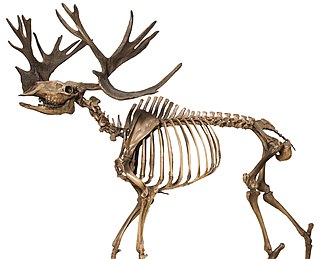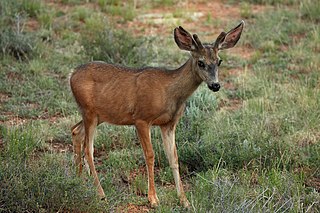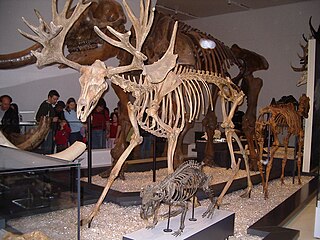
The moose or elk is the only species in the genus Alces. The moose is the tallest, and the second-largest, land animal in North America, only falling short of the American bison, in terms of mass. It is the world's tallest, largest and heaviest extant species of deer. Most adult male moose have distinctively broad, palmate antlers; other members of the deer family have antlers with a dendritic ("twig-like"), pointed configuration. Moose are winter specialists, and typically inhabit the circumpolar boreal forests or temperate broadleaf and mixed forests of the Northern Hemisphere, thriving in cooler, temperate areas as well as subarctic climates.

Chartres Cathedral, also known as the Cathedral of Our Lady of Chartres, is a Catholic church in Chartres, France, about 80 km southwest of Paris, and is the seat of the Bishop of Chartres. Mostly constructed between 1194 and 1220, it stands on the site of at least five cathedrals that have occupied the site since the Diocese of Chartres was formed as an episcopal see in the 4th century. It is one of the best-known and most influential examples of High Gothic and Classic Gothic architecture, It stands on Romanesque basements, while its north spire is more recent (1507–1513) and is built in the more ornate Flamboyant style.

Chartres is the prefecture of the Eure-et-Loir department in the Centre-Val de Loire region in France. It is located about 90 km (56 mi) southwest of Paris. At the 2019 census, there were 170,763 inhabitants in the metropolitan area of Chartres, 38,534 of whom lived in the city (commune) of Chartres proper.

The Kaskaskia were one of the indigenous peoples of the Northeastern Woodlands. They were one of about a dozen cognate tribes that made up the Illiniwek Confederation, also called the Illinois Confederation. Their longstanding homeland was in the Great Lakes region. Their first contact with Europeans reportedly occurred near present-day Green Bay, Wisconsin, in 1667 at a Jesuit mission station.

The Irish elk, also called the giant deer or Irish deer, is an extinct species of deer in the genus Megaloceros and is one of the largest deer that ever lived. Its range extended across Eurasia during the Pleistocene, from Ireland to Lake Baikal in Siberia. The most recent remains of the species have been radiocarbon dated to about 7,700 years ago in western Russia. Its antlers, which can span 3.5 metres (11 ft) across are the largest known of any deer. It is not closely related to either living species called the elk, with it being widely agreed that its closest living relatives are fallow deer (Dama).

The arrondissement of Chartres is an arrondissement of France in the Eure-et-Loir department in the Centre-Val de Loire region. It has 148 communes. Its population is 209,218 (2016), and its area is 2,129.5 km2 (822.2 sq mi).
Spatsizi Plateau Wilderness Provincial Park is located in the northern portion of British Columbia, Canada, approximately 698, 659 hectares and encompasses the Spatsizi River and Gladys Lake Ecological Reserve. The park is a designated protected area that is intended for the conservation and research on caribou, grizzly bears, fish, and other wildlife species populations. Before the provincial park's establishment in 1975, the area was a historical hunting ground for local Indigenous communities like the Tahltan First Nations.It is the second largest provincial park in British Columbia.

Libralces was a genus of Eurasian deer that lived during the Pliocene epoch. Its main claim to fame is its 2+ meter wide antlers, comparable in size to those of Megaloceros.

Cervalces scotti, also known as stag-moose, is an extinct species of large deer that lived in North America during the Late Pleistocene epoch. It is the only known North American member of the genus Cervalces. Its closest living relative is the modern moose.

The Capreolinae, Odocoileinae, or the New World deer are a subfamily of deer. Alternatively, they are known as the telemetacarpal deer, due to their bone structure being different from the plesiometacarpal deer subfamily Cervinae. The telemetacarpal deer maintain their distal lateral metacarpals, while the plesiometacarpal deer maintain only their proximal lateral metacarpals. The Capreolinae are believed to have originated in the Middle Miocene, between 7.7 and 11.5 million years ago, in Central Asia.

High Gothic followed Early Gothic architecture and was succeeded in France by Late Gothic in the form of the Flamboyant style. This timetable is not used by French scholars; they divide Gothic architecture into four phases, Primary Gothic, Classic Gothic, Rayonnant Gothic and Flamboyant Gothic. Therefore, in French terms, a few first examples of High Gothic are Classic, but most examples are Rayonnant. High Gothic is often described as the high point of the Gothic style.

The Alaska moose, or Alaskan moose in Alaska, or giant moose and Yukon moose in Canada, is a subspecies of moose that ranges from Alaska to western Yukon. The Alaska moose is the largest subspecies of moose. Alaska moose inhabit boreal forests and mixed deciduous forests throughout most of Alaska and most of Western Yukon. Like all moose subspecies, the Alaska moose is usually solitary but sometimes will form small herds. Typically, they only come into contact with other moose for mating or competition for mates. Males and females select different home ranges during different seasons. This leads to spatial segregation throughout much of the year. While males and females are spatially separate the habitat that they occupy is not significantly different. During mating season, in autumn and winter, male Alaska moose become very aggressive and prone to attacking when startled.

Cervalces latifrons, the broad-fronted moose, or the giant moose was a giant species of deer that inhabited the Europe and Asia during the Pleistocene epoch. It is thought to be the ancestor of the modern moose, as well as the extinct North American Cervalces scotti. It was considerably larger than living moose, placing it as one of the largest deer to have ever lived.

Cervalces is an extinct deer genus that lived during the Pliocene and Pleistocene epochs. Cervalces gallicus is either classified as a species of the related Libralces, or an ancestral species to other members of Cervalces. It lived in Europe from the Pliocene to the Pleistocene. Cervalces scotti, the stag-moose, lived in Pleistocene North America. Cervalces latifrons, the broad-fronted moose, and Cervalces carnutorum were found in Pleistocene Europe and Asia. The genus has been suggested to be paraphyletic and ancestral with respect to Alces, the genus which contains the modern moose, and as such, some authors synonymise Cervalces with Alces.

Praemegaceros is an extinct genus of deer, known from the Pleistocene and Holocene of Western Eurasia. It contains the subgenera Praemegaceros,Orthogonoceros and Nesoleipoceros. It has sometimes been synonymised with Megaloceros and Megaceroides, however they have been found to be generically distinct.
The canton of Chartres-1 is an administrative division of the Eure-et-Loir department, northern France. It was created at the French canton reorganisation which came into effect in March 2015. Its seat is in Chartres.
Communauté d'agglomération Chartres Métropole is an intercommunal structure, centred on the city of Chartres. It is located in the Eure-et-Loir department, in the Centre-Val de Loire region, northern France. It was created in January 2013. Its seat is in Chartres. Its area is 858.3 km2. Its population was 136,218 in 2017, of which 38,578 in Chartres proper.
The Saint-Martin-au-Val Sanctuary is a monumental Gallo-Roman temple complex still undergoing excavation in Chartres. It is one of the largest sanctuaries from Roman Gaul and is notable for its rare preservation of an ornate wooden ceiling. It featured a cult site to Diana and Apollo.

Alceini is a tribe of deer, containing the extant genus Alces and the extinct genera Cervalces and Libralces.















